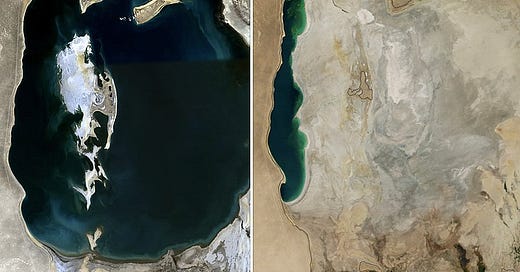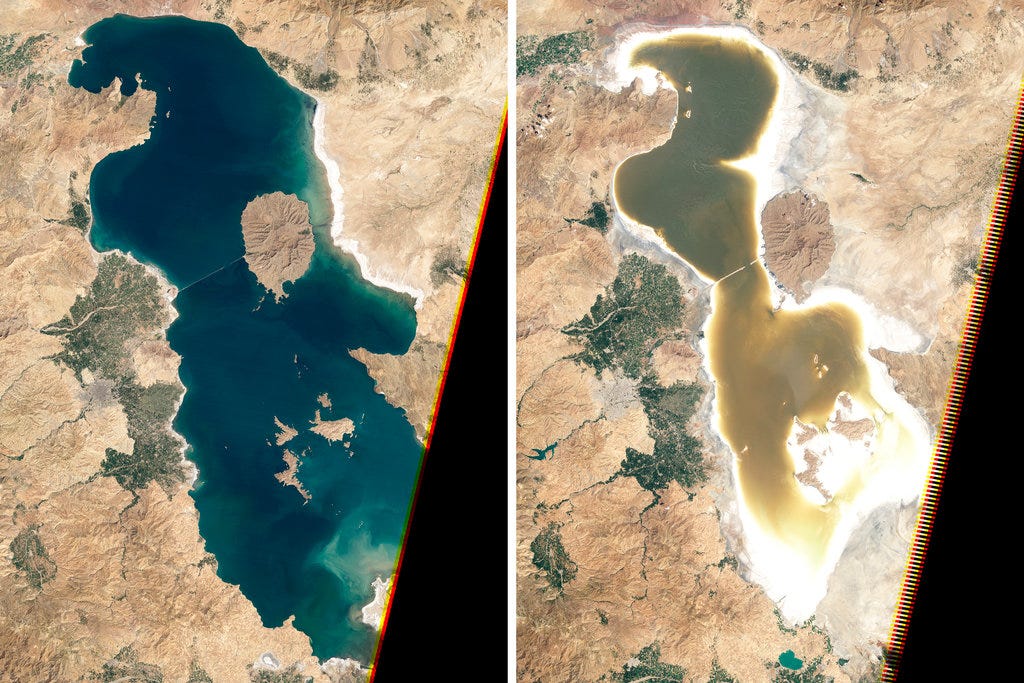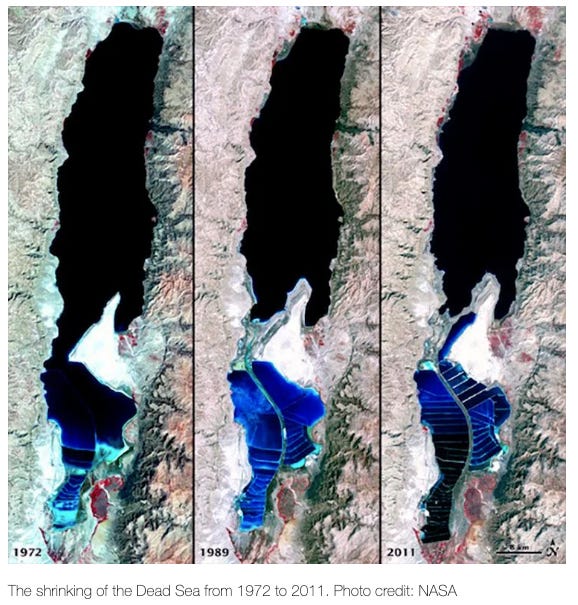What do these three watersheds have in common?
The Aral Sea, the Great Salt Lake, and the Dead Sea are three of the world’s “terminal” lakes or seas. A terminal sea is the lake that is created when it is the lowest point of a water drainage basin. That is, all water in a large area drain into this lake, not to the ocean. This type of lake will not have an outflow river, so all loss of water is through evaporation. Depending on the surface area to depth this evaporation can lead to moderate to very high levels of salinity.
Most terminal lakes, and these 3, are in arid climates. Sporadic precipitation and long season dry spells keep the water level from rising too high and cutting an exit path to the ocean.
As humans move to arid regions, we have discovered that this land is often productive with a long growing season, but without adequate water. The rivers that drain into a terminal lake are freshwater rivers, only the actual lake itself has high levels of salinity because of evaporation. To grow corps and urban areas, freshwater is necessary.
To get this freshwater, rivers emptying into these lakes were dammed or rerouted to provide water to farms, manufacturing, and urban uses instead of being allowed to run to refill the lakes. This had led to various impacts in various locations, but the common factor is the lakes are drying or have dried up.
Aral Sea
The Aral Sea was a massive body of water, the 4th largest lake in the world at one time in the 1960s. It lies between Kazakhstan and Uzbekistan, both of these soviet states in the USSR before 1990. Irrigation had started to seriously affect the Aral Sea after 1960. Previous construction had included smaller irrigation, but water was diverted on a massive scale starting in 1960. Many of these new canals were poorly built and lost water during use. Water leakage was between 35 – 70 % on the largest irrigation canal. Very few of the canals are lined to prevent water loss. The Soviet Union used this water to grow cotton, melons, rice, and cereals. The post-soviet nations still depend on this water for irrigation, and the Aral Sea is almost completely dried up.
Great Salt Lake
The Great Salt Lake is a terminal lake in Utah. It was the largest salt-water lake in America at one time. The lake is very shallow and so changes in rain and the ecosystems make the water level drop and rise. At one point in 1987 the lake was so large that pumping stations were used to decrease the amount of lake water by pumping it into a new spill lake. The. Pumps were turned off in 1989 and have not been used since. The precipitation is based on the flow of moist air from the Pacific. But even the record storms this year have not raised the level of Great Salt Lake to even the very low levels in 2021 and 2022. It is estimated that the entire lake will dry up by 1928, reappearing after large storms before drying out after winter.
The Dead Sea
The Dead Sea is at the lowest point in the world, well below sea level. It has been mentioned since pre-biblical times, and so it has been studied a lot. The Sea had been rapidly drying since the 1960s due to water usage in irrigation and human use. In 1964 Israel’s National Water Carrier plan was completed to the Dead Sea and the sea started to contract. The surface area in 2021 is approximately 66% of the surface area in 1960. The loss of input water has also led to fresh groundwater wells nearby running dry. The Dead Sea is no longer replenishing the ground water table.
Impacts to Local Populations
Less Fresh Water
The first impact is the reduction in water available for residential use. Many communities rely on the water that was heading into these lakes. As the population grew, the demands on a limited supply of water grew until they could not keep up. As these are “terminal” lakes, they stay in equilibrium by having enough water go into the lake to keep the water levels up. As damns and diversions occur on the rivers and streams which flow into the lakes, there is less water for the lake.
Water problems are exacerbated by farming methods which often do not consider the impacts downstream. Most farms in these areas don’t even have water monitors, so it is hard to know how much is being diverted. The choice of crops is driven by cheap water. Water destined for the Aral Sea is still being used to grow cotton and rice, two heavily water dependent crops. We see this same usage by farmers in Arizona and California from river water that is now scarce. The state and federal officials have discouraged growing these types of crops.
Pollution
As water levels drop in these lakes, areas that had long been underwater are now above water level and dry. This has exposed the minerals, human waste, and manufacturing byproducts that had previously been dumped into the lakes. Major pollutants are in the dry lake beds and are picked up by winds and distributed into populated areas. The Great Salt Lake is plagued by high Mercury levels and on the dried-out sections it blows over the city. The entire area around the Aral Sea is also extremely polluted and that pollution is spread over populations by strong winds. In the area around the Aral Sea heavy manufacturing also contributed to this pollution.
Critical Environmental Degradation
Very few animals can live in saltwater lakes. The salinity is higher than the ocean and not conducive to plant or animal life. However, a few species are every important for the entire food chain. The most important are the tiny “brine shrimp” which inhabited the lakes in massive numbers. The brine shrimp support migratory birds that have evolved to use these flyways. As the lakes dry up, the brine shrimp population is greatly reduced and birds are dying. This process will increase local flys, gnats and other bothersome insects, all of which these birds used to eat.
As the lake size decreases, the pollution increases in higher concentrations of minerals. Great mineral pollution has led to multiple types of animals being dangerous to eat. Subsistence fishing and hunting for pleasure are reduced or eliminated fully due to these pollutants. There are 3 different duck species in Utah that are no longer fit for human consumption since changes in the Great Salt Lake.
Of the top 25 terminal lakes as of 1960, each one has been drying up due to the causes noted above. As of 2021, 12 of them have already dried up completely. None of have been growing.
Combating Desertification
There are some simple, if not popular, solutions to these issues. I speak mainly of lakes that are still around, even in decreased size.
1. Change farm use to less thirsty plants. We need to stop irrigating fields in the desert for crops that need excessive water. This includes rice, cotton, lettuce, and other heavy water use crops. This isn’t popular with farmers as many of these crops are great cash crops. For example, Uzbekistan still uses water diverted from the Aral Sea for cotton. This cotton supports 12% of the nation’s economy.
2. Charge honest prices for water. Water prices are notoriously capricious. I am very familiar with California’s water system, so I will use this as an example. Water for irrigation in the Central Valley of California costs very little compared to residential use. Cities pay about $2,000 per acre foot for water. Farmers in California pay $40 - $120 per acre foot. During a drought the prices for extra water can range very high, but farm water is always cheaper by orders of magnitude than the cost for residential use.
Charging more, even if still very low prices, can drive changes in farming. Most almond farmers in the Central Valley have switched to drip irrigation, which drastically cuts water usage. But we have seen when water prices go back down, farming of heavy water use crops like tomatoes and cotton return.
3. Implement residential restrictions. One of the biggest wasters of water is residential landscaping. During the recent drought Southern California restricted water use for lawns but will change the restrictions back when the drought ends. In many communities, those residents that planted xeriscape (drought resistant plants) were fined or reprimanded by local regulations and homeowner associations.
In other cities water conservation has been used for a very long time. Tucson Arizona has banned residential lawns for decades, and it uses much less water per capita than other desert cities. Albuquerque and the Palm Springs area are requiring new builds to use xeriscaping.
4. Implement commercial restrictions. There are thousands of golf courses in the desert southwest. The area is famous for them. But golf courses are some of the worst water wasters around. If you looked at the golf courses in Palm Springs during the drought, you can see the difference between an expensive or country club courses where all are verdant green versus the public courses where the city can’t afford to water the grass and it is brown and dead.
Takeaway
Terminal lakes levels have dropped precipitously in the last two centuries. But the arable land has not grown. The dried areas are inhospitable to animals and people. I don’t think there is a good solution to replenish them. But as we lose these resources, the cost of water and rehabilitation to reduce pollution will increase greatly.
Alternate water replenishment, like desalinization plants, are very hard to implement in these lakes because they are, by definition, far from the ocean.
We will not understand the full implications of losing these resources until it is too late. That is why we should learn the lessons of these three bodies of water.





